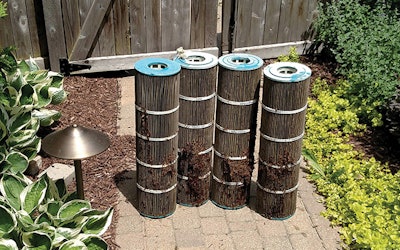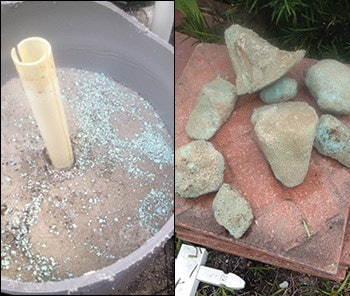
Also contributing to this story is: Dan Lenz, All Seasons Pools & Spas, Orland Park, Ill.Rich Tarricone, owner of Aquatic Pool Systems, Sarasota, Fla.Jill Tillett, co-owner of Nags Head Pools, Manteo, N.C.John Bokor, regional sales manager, ProTeamMike Fowler, commercial marketing and sales manager for Pentair Aquatic Systems, Sanford, N.C.
Today, we take on the topic of filter cleaning — how, when, where (well, that's an easy one) and what works best with which filter type. We talked to five seasoned veterans and gathered some of their insights on aquatic filtration. There may be a trick or two here you haven't thought of.
Trends In The Filter Market
Any time you have drastically different, competing technologies, you will see market movement as each new customer analyzes the different product for his own application. So it is with pool filtration. Sand, cartridge and D.E. offer radically different solutions to the problem of removing particles, and while each medium makes sense under certain conditions, in some battleground areas, cartridge is edging ahead.
Dan Lenz: In terms of filters, everything changed for us about 15 years ago when cartridge filters became larger. In the Midwest, our pools are, on average, 25- to 45,000 gallons — so they're larger than pools in, say, the Southwest. So years ago when Pentair came out with a bigger cartridge filter that didn't need to be cleaned as often, we started changing out sand filters for cartridge filters.
Prior to that, it was all sand filters. And it was a good thing at the time, because we also used to have a lot of source water from wells. But that also changed — almost all of our water comes from the city of Chicago — so we no longer have issues with metals like we used to have.
Rich Tarricone: Here in Florida I think we're about 75 percent cartridge filters. It was different when I was a kid starting out — you'd see a lot more sand filters. But in that 30 years I've been in the industry, I've seen a slow trend toward cartridge filters away from sand.
And it's kind of a good thing, I think, because you replace cartridge media more often, and you throw that away, and you're getting rid of any biofilm that could inhabit that filter. And people moving into new homes with a pool, they like that. They want to replace the filter so they're not swimming in anyone else's biofilm or filtered waste.
Here's A Tip
If you do something for a living, you pick up a few things over the years. Here are a few tips and tricks for making the job of cleaning filters easier.
Automation
Mike Fowler: Controllers can be invaluable when it comes to knowing when to backwash a dirty filter. Rather than having to do manual checks weekly, you can use an automatic controller to set backwash based on psi readings.
Chemical Treatment
John Bokor: Here are some best practices for chemically treating filter media:
Sand: Turn off inlets for all chemical feeders. With pump running and filter in the backwash position, add 6 to 16 ounces through the skimmer. You can also add directly into the filter media, and let soak for four hours or longer. After soaking, make sure to start the pump with the filter in the backwash position.
Cartridge and D.E. filters: Simply remove the media from the filter and spray from top to bottom. Allow to stand for five minutes. Rinse thoroughly with a hose and replace for normal operation.
The service professionals who do the best work are those who take the filter media with them when they close the pool for the season, clean it at their shops and bring back clean, ready-to-use filters in the spring when they re-open the pool. They charge extra for the filter cleaning service and they have a customer with cleaner pool water all summer.
Use a little D.E. on the filter cartridge
Dan Lenz: Our best tip or trick when it comes to cleaning cartridge filters is to use a little D.E. on the filter cartridge at the beginning of each season. The D.E. puts a superfine coating on the filter cartridge that makes cleaning the filter much easier. We bring all our filters cartridges into the shop to clean. A little pre-treatment with D.E. makes all the debris fall off without a lot of work — and those cartridges really can be labor intensive to clean. We put about 1 pound of D.E. to every 100 square feet.
Filters In Hot Water
In the Outer Banks of North Carolina, Nags Head Pools keeps vacation rental spas in top condition by keeping a sharp eye on the filter.
Jill Tillett: There are as many as 10,000 hot tubs in our county and almost all of them use cartridge filtration. Due to the temperature difference between pools and hot tubs, cartridge filters on hot tubs catch a lot of exfoliated skin and oils, as they are filtering a smaller, warmer body of water. So you have to use a chemical cleaner.
We clean our cartridge filters at least once a week with a degreasing filter cleaner and occasionally soak them in dichlor for extra sanitation when hot tubs are dumped and refilled.
Also, every cartridge is replaced at the beginning of the season.
Pleats Under Pressure: VSPs Change The Equation
The growing use of variable speed pumps has led to some confusion among those trained to look at pressure differential as the sole means of determining when a filter should be cleaned or replaced. For many years in the era of high-horsepower, single-speed pumps, the procedure was straightforward. Now, with variable speed pumps that may run at different rpm, checking the pressure drop isn't quite as simple.
Rich Tarricone: With new technology there are always new challenges, and that's definitely the case with variable speed pumps.
These variable speed pumps, they're just great, they run quiet, they save a ton of money and filter better, but at low flow, they may not be producing enough pressure to raise the pressure on the filter gauge the recommended 5 psi, even if the filter is clogged.
Now when we sell variable speed pumps, we tell people you have to create a couple of reference points to know if the filter is dirty. So you push speed 4, take it all the way up to high speed, and create a couple reference points — if it's 20 psi when it's clean and 25 psi when it's dirty, all at high speed, that's how you know from now on when your filter needs to be cleaned.
Dan Lenz: In the past it was simple, the pump was either on or off and you just took the psi measurement. But now that the pump isn't on at full flow all the time, it becomes harder to get an accurate psi reading because as flow increases, pressure increases — and not necessarily because of a dirty filter.
We tell our customers to turn their pump on high-speed once a week and take a note of the psi at that time. We tell them to keep track and then tell us when the psi increases beyond 5 lbs. This is now a part of the weekly maintenance, along with cleaning the baskets, skimmer etc.
We are very diligent about keeping a log of all our pool sites each time we service the pools. We record 40 to 50 items when we are out there and have our service techs put that record on their mobile device, which goes right into our Evosus business software.
One of the most important figures we note is the initial psi on the gauge at the top of the filter tank. This really helps when we get a call in the summer and the consumer says their pool water is cloudy or their heater isn't running. The first thing we do is pull up their profile then ask them to go to the filter and give us the psi reading. If it was 18 when we opened the pool and now it's at 32, we know to tell them to backwash the filter and when they do, that their heater will now get enough water to work and their water will clear up pretty quickly. This always seems to happen right before a big pool party, so it's great to be able to solve the problem over the phone rather than having to try to schedule a tech to go out to the pool.
Sticking to that 5-pound rule of thumb really prolongs the life of a cartridge filter. We just had a customer come in after 13 years to buy their first new cartridge filter — because he was diligent about watching the 5-pound psi increase and cleaning at that point. We find that if you wait for a 10-pound change in pressure, the pleats begin to collapse and the bands start to break.
A Diligent Process
In business, disciplined procedure is the foundation of success, and the same is true of filter cleaning. Sticking to a proven routine can ensure a reliable, consistent result. Here's how they do it at All Seasons in Chicago.
Dan Lenz: We use a multi-step process: First, we hose off the filter from top to bottom using a normal garden hose. We never pressure wash because the bands that hold the pleats in place can snap under pressure and then the pleats collapse on themselves reducing the surface area of filtration.
After hosing down the cartridges we put them through a soaking process overnight. We place the cartridges in 55 gallon plastic buckets that contain muriatic acid and a filter cleaning agent.
Once they have soaked over night, we lightly rinse them and then place them in a clear water drum to soak again. Finally we soak the filters in a liquid chlorine solution to brighten and lighten them — so they look nicer when we give them back to the client. Sometimes we need to repeat the steps depending on how dirty the filter cartridges are.
Once the cartridge is clean, we find it best to air-dry the cartridge before re-using. We suggest that the pool owner have two sets of cartridges, so while one is being cleaned, you have another in use. This then provides time for the cartridge to dry out so fibers fluff-up — those fibers need to expand to be effective. If not, they are easily pushed down which can also reduce filter cycle time.
SandyLand
There are areas where you can't find a sand filter on a residential pool to save your life. And other areas where they are the dominant mode of filtration.
Jill Tillett: Here on the Outer Banks, most of our pools use high rate sand filters to maintain swimming pool water. We use sand because it's more tolerant for vacuuming all of the sand that is blown into the pools on the sea breezes from our beautiful beaches.
High-rate sand systems filter down to 25 microns, and they are relatively easy to maintain but they do require media replacement about every five years.
My general rule of thumb is to replace the sand every four years on a 200-pound tank, five years on a 250-pound tank and six years on a 300-pound tank, etc. We recommend a gentle shock and clarifier every 7 to 14 days to help the sand filter out smaller particles.
Mike Fowler: Sand filters in particular need to be monitored to be sure the media inside the tank stays smooth and not solidified. Opening the lid (after making sure the pump is off) and doing a quick inspection will tell you a lot about how the sand is doing and if it should be changed or backwashed. New regenerative media like glass beads is another option to consider.
It's also important to maintain the filter valves. If they aren't maintained, the gaskets might need to be replaced as they can be a source of water loss.
You Can't Be Too Rich, But You Can Be Too Clean
A little buildup of debris in a filter is actually a good thing.
Rich Tarricone: Some people like to keep everything clean at all times, but you can clean a filter too often. Because a filter captures dirt, which is sanitized, and that dirt buildup acts as a filter to capture finer dirt, which is sanitized, and so you start to collect finer and finer particles and actually filter better. At some point you've completed a whole cycle and it's time to start over.
I've talked to homeowners taking care of their own pools who have told me, "I can't get my water clear. And I'm cleaning my filter every day."
And I tell them, "That's the first thing you're doing wrong. We need to start clogging your filter up with filter enhancers, and get it to the point where it will start filtering the finer dirt, because right now that fine dirt going right through the media."
|
|












































